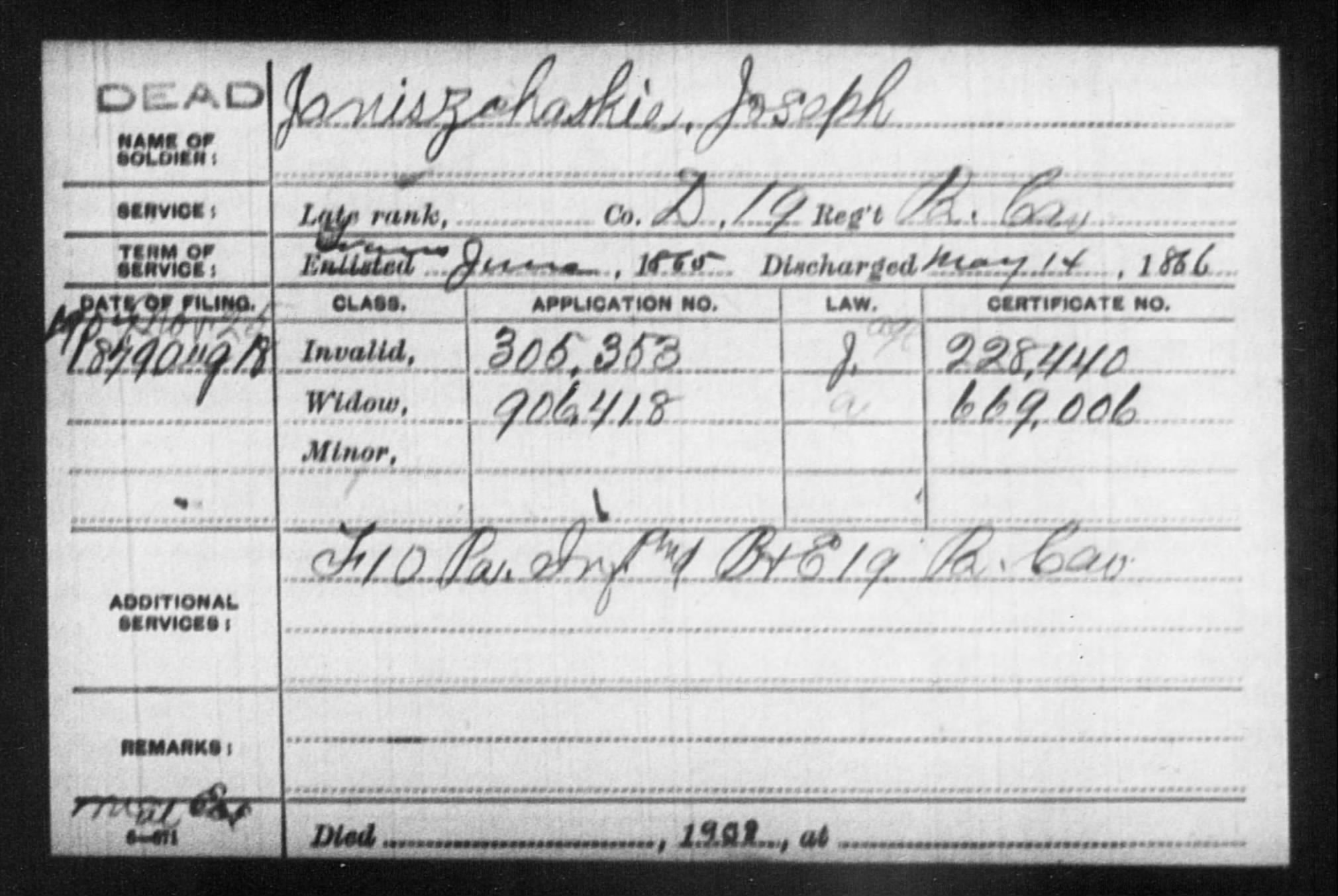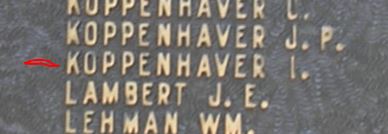Posted By Norman Gasbarro on July 13, 2016

Jacob Keener, son of Jacob Keener (1823-1902) and Barbara [Weltmer] Keener (1822-1901) enrolled in the 127th Pennsylvania Infantry, Company D, as a Private, in Harrisburg, on 7 August 1862. He gave his age as 19, his occupation as farmer, and his residence as Lykens. He is one of many Civil War veterans who at one time in their life called Lykens home, but for whatever reason were not recognized on the Lykens G.A.R. Monument.

On 22 July 1924, Jacob Keener‘s obituary appeared in the Hutchinson News of Kansas:
Jacob Keener
Hoisington, Kansas, 22 July 1924 — Jacob Keener, 80, a pioneer settler of this county, died Saturday at Denver, Colorado, where he was visiting with a grandson. He was ill but two days. Mr. and Mrs. Keener went to Colorado last week. He was one of the pioneer settlers of West Eureka Township. The body was brought here and the funeral held this afternoon.
The obituary did not mention his Civil War service.

The Findagrave Memorial for Jacob Keener does mention Keener’s Civil War service, but no G.A.R. star-flag holder is shown at his grave site. The biographical sketch for him on that website, composed by York County Pennsylvania Civil War researcher Dennis Brandt, includes service in the 20th Pennsylvania Cavalry. It also includes the names of his children and their approximate dates of birth.

Jacob Keener applied for a pension on 24 August 1883, which he received and collected until his death in 1924. His widow followed with an application for benefits and she received them until her death. The above Pension Index Card from Fold3 notes Jacob’s service in the 127th Pennsylvania Infantry, the 20th Pennsylvania Cavalry, and the 1st Pennsylvania Provisional Cavalry, the latter regiment being an end-of-the-war consolidated unit.
The following information was found in A Standard History of Kansas and Kansans, by William E. Connelley, published by Lewis Publishing Company, 1919.
JACOB KEENER. Forty years have come and gone since this veteran Union soldier unloaded his family and goods and began a permanent residence in Barton County. So far as economic fruitfulness and the well being of the inhabitants are concerned, all the history of Barton County worth mentioning has been made in these four decades, and in that epoch Jacob Keener has played no unimportant part as a home maker, farmer and good citizen….
Mr. Keener was born about eight miles northeast of Harrisburg in Dauphin County, Pennsylvania, 27 July 1844, a grandson of Frederick Keener and member of a family of early settlers in the Keystone state. Jacob Keener Sr., a native of the same section, was a stonemason by trade and died in Dauphin County. He saw active service with a Pennsylvania regiment during the Civil War. His wife, Barbara Weltmer, who died at the age of eighty-four, was the mother of one child.
A thorough school education was denied Mr. Keener, partly due to the fact that he was only seventeen when he enlisted at Harrisburg, in Company D of the Hundred Twenty-seventh Pennsylvania Infantry, under Colonel Jennings, and marched away to fight the battles of the Union. During this ten months’ term he was with the Army of the Potomac in the defense of Washington and in two of the hardest fought battles of the war, Fredericksburg and Chancellorsville. He then re-enlisted, joining the Twentieth Pennsylvania Cavalry under Colonel Winecoop. Most of this service was in the Shenandoah Valley, fighting at Piedmont, Lynchburg, Ashby Gap, Winchester, Martinsburg, Somerset, with Sheridan’s cavalry in the Deep Bottom Campaign, and was at Appomattox when Lee surrendered on 9 April 1865. A Chancellorsville a shrapnel slug struck him in the groin, without inflicting a serious wound. Another time, after coming off picket duty with two Confederate prisoners, and while cold and exasperated, he jammed his carbine into the ground, causing it to explode, the ball grazing the cheek and knocking him numb without quite breaking the skin of his face. He was in the Grand Review at Washington, and was mustered out a Private at Philadelphia, with a dozen or more battles to his credit, and with more than two years of real service to commend him to the patriots of our day.
As a civilian he took up the stonemason’s trade, and for several years his work was with the mallet and chisel and trowel. For five years he was in a blast furnace, making pig iron at Harrisburg, and then had three years of practical farming experience before making his final and best adventure as Kansas pioneer.
On 18 April 1878, a train brought him to Great Bend. In the party were his wife and four children, his mother, and his uncle, Abraham Weltmer, who spent his last years in Dauphin County. The family remained at Great Bend a few weeks until he found suitable land and location….
Some reference should be made to his experience in horticulture. The family planted bush and tree fruits of difference kinds, but the only thing that seemed to justify the labor and pains was peaches, and one year the grasshoppers ruined the orchard, and after that it was practically abandoned. Mr. Keener was a farmer on his own land for twenty-two years, at the end of which time he and his good wife felt their strenuous toil deserved a rest, and the accordingly moved to Hoisington….
While in the country Mr. Keener was a member of the school board…. After one term as trustee of Eureka Township Mr. Keener was re-elected, but resigned the office. He has been a Republican voter since he first helped elect Grant in 1868. He is a member of the United Brethren Church, and his wife is one of the “Brethren” congregation.
In his native county of Dauphin, 10 March 1868, Mr. Keener married Elizabeth Ziegler. She was born 13 March 1844, daughter of Emanuel Ziegler and Anna [Eshleman] Ziegler. Her father, a native of Lancaster County, that state, was a wagon maker for several years, and afterwards a farmer….
Mr. and Mrs. Keener have seven living children:
Emanuel Keener, of Hoisington, first married Dora Hamilton, and second, Clara Hanson. His two children by his first wife, John Keener and Hamilton Keener, were soldiers in the war with Germany.
Samuel Keener, the second child, is a farmer in Barton County, and by his marriage to Fannie Fiester has six children….
Mary Keener, wife of Al J. Brown, of Hoisington is the mother of [five]….
Daniel Keener, a farmer of Barton County, married Myrtle Shaw.
George Keener, also numbered among the agricultural element in this section, married Beatrice Harper….
Cora Keener became the wife of Ed Mathewson, of LaCrosse, Kansas….
Ella Keener, the youngest of this interesting family group, is the wife of Floyd Wingert, of Hoisington….
As mentioned in the biographical sketch, Jacob Keener‘s father also served in the Civil War. Jacob Keener Sr. was a member of the 201st Pennsylvania Infantry, Company I, serving as a Private, from 30 August 1864 through muster out on 21 June 1865. The father was a member of Post No. 58, G.A.R., in Harrisburg, and this was reported in his obituary which appeared in the Harrisburg Patriot. Jacob Keener Sr. died in Halifax Township, Dauphin County, on 18 September 1902, and it is in that area of Dauphin County, approximately eight miles northeast of Harrisburg, where Jacob Keener Jr. was born and raised. It is not known why Junior was living in Lykens in 1862 but it probably can be assumed that at that time he was learning farming.
Since Jacob Keener Jr. lived until 1924, it can be assumed that a picture of him has survived and can be located through one of his descendants. If anyone has such a picture, a digital image of it would be greatly appreciated by the Project!
The newspaper clipping is from Newspaper.com. The biographical sketch from the Kansas history was provided by a descendant.
Category: Research, Resources, Stories |
Comments Off on Jacob Keener Jr. – Lykens Resident, Moved to Kansas
Tags: G.A.R., Halifax Township, Lykens Borough
 ;
;


















